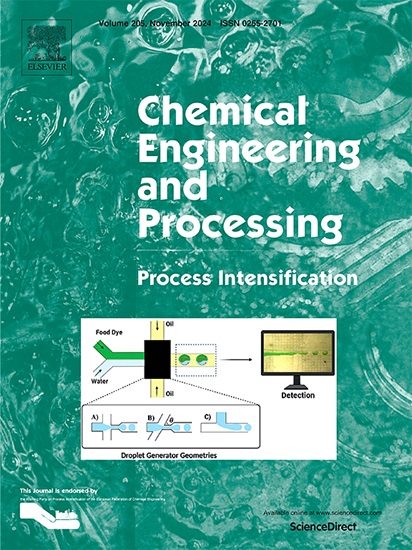Electrified dehydrogenation of methyl-cyclohexane: reactor modeling and process integration
IF 3.9
3区 工程技术
Q3 ENERGY & FUELS
Chemical Engineering and Processing - Process Intensification
Pub Date : 2025-05-18
DOI:10.1016/j.cep.2025.110368
引用次数: 0
Abstract
Liquid Organic Hydrogen Carriers (LOHC) have been proposed as hydrogen transport technology to overcome limitations related to its low volumetric density. However, the dehydrogenation step represents the technological bottleneck of the LOHC storage cycle. In this work, a process layout based on the adoption of an electrified packed foam reactor for the dehydrogenation of the LOHC pair Methyl-cyclohexane/Toluene (MCH/TOL) is reported for an intensified CO2-free cycle. The effects on reactor performance of operating parameters such as Gas Hourly Space Velocity (GHSV), outlet pressure, and inlet temperature are studied. The proposed reactor reaches volumetric hydrogen productivity, expressed in terms of H2 lower heating value of 3.18 with 95 % of MCH conversion, improving the results of intensified reactor configurations reported in the literature. The reactor is then integrated into a process layout considering a large-scale hydrogen refueling station as a case study, and process-related KPIs are calculated. The designed dehydrogenation process provides 1000 kg day-1 of hydrogen, with a purity of 99.8 %, and a specific consumption of 13.46 This work represents the first application of an electrified packed-foam reactor to LOHC dehydrogenation and its integration in process simulation. It also potentially represents the starting point for future optimization studies to assess the competitiveness of this hydrogen transport technology.

甲基环己烷电解氢:反应器建模和工艺集成
液态有机氢载体(LOHC)被提出作为氢传输技术,以克服其低体积密度的限制。然而,脱氢步骤是LOHC储存循环的技术瓶颈。本文报道了一种基于电气化填充泡沫反应器的LOHC对甲基-环己烷/甲苯(MCH/TOL)脱氢的强化无co2循环工艺布局。研究了气时空速(GHSV)、出口压力、进口温度等运行参数对反应器性能的影响。该反应器达到了体积产氢率,以H2较低热值3.18 kWH2 - LHVLR - 1表示,MCH转化率为95%,改善了文献中报道的强化反应器配置的结果。然后以大型加氢站为例,将反应器集成到工艺布局中,并计算与工艺相关的kpi。设计的脱氢工艺可提供1000 kg day-1氢气,纯度为99.8%,比耗为13.46 kWhkgH2−1。该工作首次将电气化填充泡沫反应器应用于LOHC脱氢并将其集成到工艺模拟中。它也可能代表了未来优化研究的起点,以评估这种氢运输技术的竞争力。
本文章由计算机程序翻译,如有差异,请以英文原文为准。
求助全文
约1分钟内获得全文
求助全文
来源期刊
CiteScore
7.80
自引率
9.30%
发文量
408
审稿时长
49 days
期刊介绍:
Chemical Engineering and Processing: Process Intensification is intended for practicing researchers in industry and academia, working in the field of Process Engineering and related to the subject of Process Intensification.Articles published in the Journal demonstrate how novel discoveries, developments and theories in the field of Process Engineering and in particular Process Intensification may be used for analysis and design of innovative equipment and processing methods with substantially improved sustainability, efficiency and environmental performance.

 求助内容:
求助内容: 应助结果提醒方式:
应助结果提醒方式:


